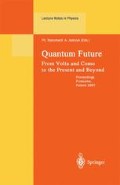Abstract
The Solvay conference of 1927 marked the birth of quantum theory. This theory constitutes a radical break with prior tradition in physics, because it avers, if taken seriously, that nature is built not out of matter but out of knowings. However, the founders of the theory stipulated, cautiously, that the theory was not to be taken seriously, in this sense, as a description of nature herself, but was to be construed as merely a way of computing expectations about future knowings on the basis of information provided by past knowings. There have been many efforts over the intervening seventy years to rid physics of this contamination of matter by mind. But I use the reports at this Symposium to support the claim that these decontamination efforts have failed, and that, because of recent developments pertaining to causality, the time has come to take quantum theory seriously: to take it as the basis for a conception of the universe built on knowings, and other things of the same kind. Quantum theory ensures that this conception will yield all the empirical regularities that had formerly been thought to arise from the properties of matter, together with all of those more recently discovered regularities that cannot be understood in that mechanical way. Thus I propose to break away from the cautious stance of the founders of quantum theory, and build a theory of reality by taking seriously what the incredible accuracy of the predictions of the formalism seems to proclaim, namely that nature is best understood as being built around knowings that enjoy the mathematical properties ascribed to them by quantum theory. I explain why this idea had formerly been incorrectly regarded as untenable, due to a failure to distinguish signals from influences: relativistic quantum field theory ensures both that signals cannot travel faster than light, but that influences, broadly conceived, cannot be imagined to enjoy that property. Failure to recognize this fact had made a realistic interpretation of quantum theory seem impossible. I then explain how our conscious knowings can play a causally efficacious and binding role in brain dynamics without violating the statistical rules of quantum theory, and describe how these features provide a foundation for understanding how consciousness could have evolved by natural selection from primitive beginnings.
This work was supported by the Director, Office of Energy Research, Office of High Energy and Nuclear Physics, Division of High Energy Physics of the U.S. Department of Energy under Contract DE-AC03-76SF00098.
Preview
Unable to display preview. Download preview PDF.
References
Bohr, N. (1934), Atomic Theory and the Description of Nature (Cambridge: Cambridge University Press).
Bunge, M. (1967), Quantum Theory and Reality (Berlin: Springer).
Einstein, A. (1951) Albert Einstein: Philosopher-Scientist ed. P.A. Schilpp (New York: Tudor).
Fogelson, A.L. & Zucker, R.S. (1985), ‘Presynaptic calcium diffusion from various arrays of single channels: Implications for transmitter release and synaptic facilitation', Biophys. J., 48, pp. 1003–1017.
Feynman, R., Leighton, R., and Sands, M., (1965) The Feynman Lectures in Physics. (Vol. III, Chapter 21). (New York: Addison-Wesley).
Haag, R. (1996) Local Quantum Physics (Berlin: Springer), p 321.
Heisenberg, W. (1958a) ‘The representation of nature in contemporary physics', Deadalus bf 87, 95–108.
Heisenberg, W. (1958b) Physics and Philosophy (New York: Harper and Row).
Hendry, J. (1984) The Creation of Quantum Theory and the Bohr-Pauli Dialogue (Dordrecht: Reidel).
Kawai, T. and Stapp, H.P. (1995) ‘Quantum Electrodynamics at large distance I, II, III', Physical Review, D 52 3484–2532.
Joos, E. (1986) ‘Quantum Theory and the Appearance of a Classical World', Annals of the New York Academy of Science 480 6–13.
Omnes, R. (1994) The Interpretation of Quantum Theory, (Princeton: Princeton U.P.) p. 498.
Stapp, H.P. (1975) ‘Bell's Theorm and World Process', Nuovo Cimento 29, 270–276.
Stapp, H.P. (1977) ‘Theory of Reality', Foundations of Physics 7, 313–323.
Stapp, H.P. (1979) ‘Whiteheadian Approach to Quantum Theory', Foundations of Physics 9, 1–25.
Stapp, H.P. (1983) ‘Exact solution of the infrared problem’ Physical Review, 28 1386–1418.
Stapp, H.P. (1993) Mind, Matter, and Quantum Mechanics (Berlin: Springer), Chapter 6. & http://www-physics.lbl.gov/~stapp/stappfiles.html
Stapp, H.P. (1996) ‘The Hard Problem: A Quantum Approach', Journal of Consciousness Studies, 3 194–210.
Stapp, H.P. (1997) ‘Nonlocal character of quantum theory', American Journal of Physics, 65, 300–304. For commentaries on this paper see: http://www-physics.lbl.gov/~stapp/stappfiles.html The papers quant-ph/yymmnnn cited there can be accessed at quant-ph@xxx.lanl.gov by putting in the subject field the command: get yymmnnn
Stapp, H.P. (1997a) 'science of Consciousness and the Hard Problem', J. of Mind and Brain, vol 18, spring and summer.
Stapp, H.P. (1997b) ‘The Evolution of Consciousness', http://www-physics.lbl.gov/~stapp/stappfiles.html
Wigner, E. (1961) ‘The probability of the existence of a self-reproducing unit', in The Logic of Personal Knowledge ed. M. Polyani (London: Routledge & Paul) pp. 231–238.
Zucker, R.S. & Fogelson, A.L. (1986), ‘Relationship between transmitter release and presynaptic calcium influx when calcium enters through disrete channels', Proc. Nat. Acad. Sci. USA, 83, 3032–3036.
Zurek, W.H. (1986) ‘Reduction of the Wave Packet and Environment-Induced Superselection', Annals of the New York Academy of Science 480, 89–97
Zurek, W.H., S. Habib, J.P. Paz, (1993) ‘Coherent States via Decoherence', Phys. Rev. Lett. 70 1187–90.
Author information
Authors and Affiliations
Editor information
Rights and permissions
Copyright information
© 1999 Springer-Verlag
About this paper
Cite this paper
Stapp, H.P. (1999). Quantum ontology and mind-matter synthesis. In: Blanchard, P., Jadczyk, A. (eds) Quantum Future From Volta and Como to the Present and Beyond. Lecture Notes in Physics, vol 517. Springer, Berlin, Heidelberg. https://doi.org/10.1007/BFb0105346
Download citation
DOI: https://doi.org/10.1007/BFb0105346
Published:
Publisher Name: Springer, Berlin, Heidelberg
Print ISBN: 978-3-540-65218-2
Online ISBN: 978-3-540-49482-9
eBook Packages: Springer Book Archive

